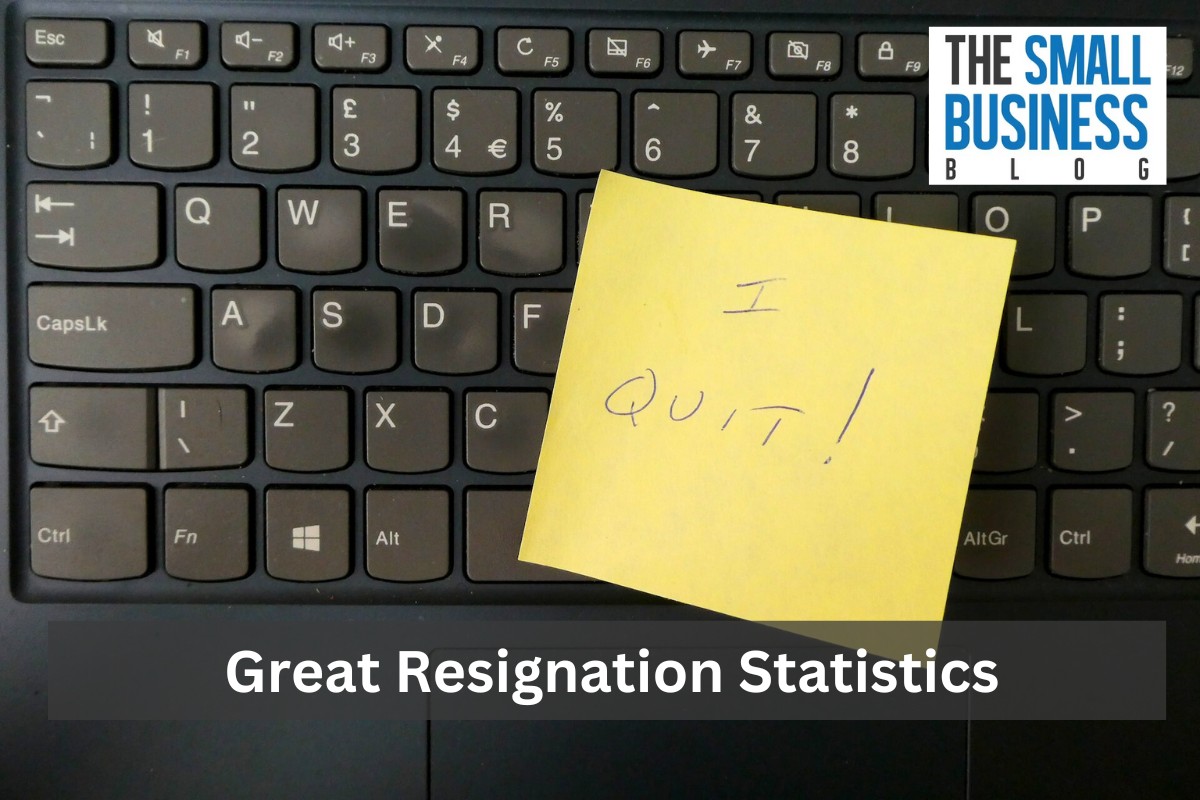In recent times, the employment landscape has witnessed a seismic shift.
The phenomenon known as the “Great Resignation” has taken hold, and it’s reshaping the way we think about work.
People from various industries and professions are opting to leave their jobs all together, seeking change, fulfillment, and a better work-life balance.
This article delves into the factors behind this transformative movement and its implications for both individuals and organizations so read on to learn more!
Post Contents
- 1 Key Statistics
- 2 Top Great Resignation Statistics in 2024
- 2.1 1. Over 50 Million Workers Quit Their Jobs in 2022
- 2.2 2. March 2022 Alone Witnessed a Total of 4.5 Million Job Resignations
- 2.3 3. The Industry of Accommodation and Food Services Had a Quit Rate of 6.9%
- 2.4 4. Federal Government Industry Has Lowest Quit Rate in 2021, with 0.7%
- 2.5 5. 11.5 Million Job Vacancies Are Reported in March 2022
- 2.6 6. 26% of Workers Who Quit Their Jobs During the Great Resignation Regretted Their Decision
- 2.7 7. 53% of Retired Individuals Wish to Return to Work
- 2.8 8. In March 2022, Wage Growth Rate is at 6%
- 2.9 9. 78% of People Currently Employed Believe That Changing Jobs Would Lead to Improved Salaries
- 2.10 10. Dissatisfaction Led 42% of Individuals to Leave Their Jobs
- 3 Conclusion
- 4 Sources
Key Statistics
- In 2022, a staggering 50 million employees left their occupations
- The number of job quitters in a month reached 4.5 million in March 2022
- Within the accommodation and food services sector, 6.9% of employees resigned
- Among all industries, the Federal Government had the lowest quit rate in 2021, measuring 0.7%
- The reported number of job vacancies in March 2022 was 11.5 million
- Among job quitters, 26% admitted to feeling regret about their decision
- 53% of employees who resigned during the Great Resignation wish to work again
- The Wage Growth Rate for March 2022 is recorded at 6%
- A significant majority (78%) of employed individuals are confident they can secure higher salaries by switching jobs
- 42% of job quitters mentioned dissatisfaction as the motive for their resignation
Top Great Resignation Statistics in 2024

1. Over 50 Million Workers Quit Their Jobs in 2022
Federal data reveals that over 50 million workers made the bold decision to quit their jobs in 2022, surpassing the record set in the previous year.
This unprecedented wave of voluntary departures demonstrates the resilience and strength of the current job market.
The trend of employees willingly parting ways with their employers began to gain momentum in early 2021, as the United States economy slowly emerged from the constraints of the pandemic.
(CNBC)
2. March 2022 Alone Witnessed a Total of 4.5 Million Job Resignations
In recent times, there has been a significant surge in the number of individuals deciding to leave their jobs, a phenomenon that has caught the attention of economists and labor market analysts alike.
According to data, a record-breaking 4.5 million workers voluntarily quit their jobs in March 2022, surpassing the previous month’s figures by an impressive 152,000.
The growing willingness among employees to leave their current positions may also be indicative of shifting power dynamics between employers and workers.
With job openings reaching unprecedented levels, individuals now have more options and bargaining power when it comes to their professional lives.
(Bureau of Labor Statistics)
3. The Industry of Accommodation and Food Services Had a Quit Rate of 6.9%

The Great Resignation has affected diverse sectors, with each industry experiencing unique dynamics and contributing factors to the rising employee turnover.
Let’s delve into a few key industries and explore the insights exposed from this unprecedented trend:
- The industry of accommodation and food services had a quit rate of 6.9%
- The industry of leisure and hospitality had a quit rate of 6.4%
- The industry of retail trade had a quit rate of 4.7%
- The industry of professional and business services had a quit rate of 3.7%
- The industry of trade, transportation, and utilities had a quit rate of 3.6%
- The industry of education and health services had a quit rate of 2.8%
- The industry of construction had a quit rate of 2.7%
- The industry of manufacturing had a quit rate of 2.3%
- The industry of durable goods had a quit rate of 2.1%
- The industry of mining and logging had a quit rate of 2%
- The industry of information had a quit rate of 2%
(Zippia)
4. Federal Government Industry Has Lowest Quit Rate in 2021, with 0.7%
While the Federal Government Industry exhibited the lowest quit rate in 2021 at a mere 0.7%, a striking contrast emerges when comparing it to other sectors.
Other industries experienced significantly higher rates of employee departures, highlighting the trend of increased job mobility and reevaluation of professional priorities.
One key factor that has likely contributed to the Federal Government Industry’s low quit rate is its reputation for stability and job security.
Amidst the economic uncertainties brought about by the pandemic, many employees sought stability in their careers.
The Federal Government, known for its robust employment benefits, including retirement plans, healthcare, and job protection, provided a sense of security during these turbulent times.
This stability likely dissuaded many employees from voluntarily leaving their positions.
(Zippia)
5. 11.5 Million Job Vacancies Are Reported in March 2022
The Great Resignation has sparked a flurry of job openings, with the last business day of March 2022 reporting a record-breaking 11.5 million vacancies, the highest ever recorded since data collection began in December 2000.
Although the number of job openings remained relatively stable during this period, the job openings rate stood at 7.1%, showcasing a remarkable level of opportunity in the market.
However, not all sectors witnessed positive growth.
The transportation, warehousing, and utilities industries faced a decline of 69,000 job openings.
(Bureau of Labor Statistics)
6. 26% of Workers Who Quit Their Jobs During the Great Resignation Regretted Their Decision
A recent survey conducted reveals that a surprising proportion of these individuals now regret their decision.
According to the survey, one in four workers who quit their previous job expressed remorse, highlighting various factors that contribute to their change of heart.
Interestingly, the most prevalent reason cited for these regrets is the absence of a new job lined up before resigning.
Many individuals find themselves struggling to secure new employment, despite the current labor market’s abundance of job opportunities compared to the number of unemployed workers.
This unexpected hurdle may have caught these workers off guard, leading to second thoughts about their decision to leave their previous position.
(Statista)
7. 53% of Retired Individuals Wish to Return to Work

In a recent study, a staggering 53% of retired individuals who are actively seeking employment expressed happiness in returning to work.
This statistic challenges the conventional notion of retirement as a phase solely meant for relaxation and leisure.
Many retirees find purpose, fulfillment, and a sense of accomplishment in pursuing work-related endeavors, which motivates them to rejoin the workforce.
While financial considerations do play a role for some retirees re-entering the workforce, the survey reveals that only 27% cite monetary reasons as their primary motivation.
This finding indicates that the decision to return to work is not solely driven by economic pressures.
Instead, retirees are recognizing the non-financial advantages of working, such as maintaining mental and physical well-being, staying socially connected, and enjoying a sense of purpose.
By staying active in the workforce, retirees can maintain a healthy work-life balance and continue to lead fulfilling lives.
(Joblist)
8. In March 2022, Wage Growth Rate is at 6%
As employees leave their positions in droves, companies are faced with the challenge of attracting and retaining talent in an increasingly competitive landscape.
To entice skilled workers and dissuade them from joining the resignation wave, organizations have resorted to offering higher wages.
This wage growth is a direct response to the increased demand for skilled individuals and the need to maintain a motivated workforce.
The following statistics were collected throughout the course of the Great Resignation:
- In May 2021, the rate at which wages grew is 3%
- In June 2021, the rate at which wages grew is 3.2%
- In July 2021, the rate at which wages grew is 3.7%
- In August 2021, the rate at which wages grew is 3.9%
- In September 2021, the rate at which wages grew is 4.2%
- In October 2021, the rate at which wages grew is 4.1%
- In November 2021, the rate at which wages grew is 4.3%
- In December 2021, the rate at which wages grew is 4.5%
- In January 2022, the rate at which wages grew is 5.1%
- In February 2022, the rate at which wages grew is 5.8%
- In March 2022, the rate at which wages grew is 6%
(Federal Reserve Bank of Atlanta)
9. 78% of People Currently Employed Believe That Changing Jobs Would Lead to Improved Salaries
An overwhelming 78% of employed job seekers believe that they can attain better financial prospects by exploring new career paths.
This profound mindset shift reflects a growing desire among individuals to seek greener pastures and capitalize on emerging opportunities.
The motivation to pursue better financial opportunities has emerged as a dominant driver in the decision-making process for many job seekers.
By leveraging their skills, experience, and market demand, employees believe they can unlock higher earning potential by seeking alternative employment.
The idea of abandoning the status quo and taking a leap of faith in pursuit of a more prosperous future has become increasingly appealing.
(Joblist)
10. Dissatisfaction Led 42% of Individuals to Leave Their Jobs

According to findings, 42% of those who have recently resigned cite dissatisfaction with their new job as the primary reason for their departure.
Interestingly, when asked about the possibility of returning to their previous employer, 59% firmly ruled out this option.
This suggests that these individuals are seeking a fresh start and are not willing to go back to their old job, despite any potential benefits or offers that might be presented to them.
On the other hand, 17% expressed a willingness to return, indicating that some employees may reconsider if certain conditions or improvements are made.
(Statista)
Conclusion
The Great Resignation Statistics shows a pivotal moment in the world of work, emphasizing the growing need for a more holistic approach to career choices.
As individuals increasingly prioritize personal fulfillment and well-being, organizations must adapt to meet these changing expectations.
By embracing flexibility, supporting work-life balance, and nurturing a culture that empowers employees, organizations can not only retain their workforce but also thrive in this new era.
Ultimately, the Great Resignation serves as a catalyst for a transformative shift, urging us to redefine the way we perceive work, success, and happiness in our lives.






























